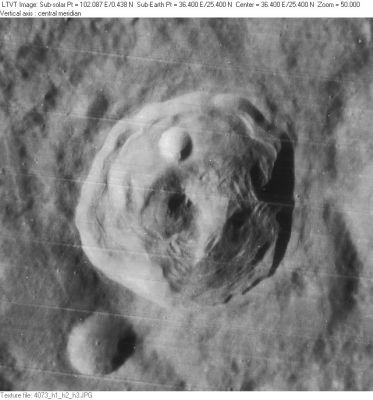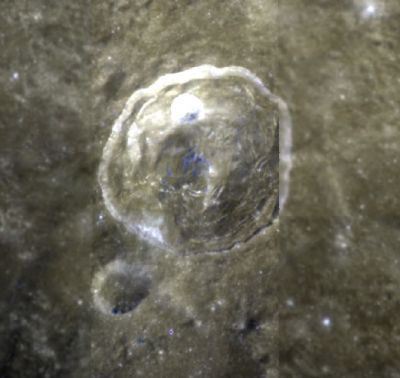Römer
Contents
Römer
|
Lat: 25.4°N, Long: 36.4°E, Diam: 39 km, Depth: 3.5 km, Rükl: 25, Copernican |


Left: Lunar Orbiter IV-073-H3, Right: Clementine color image The crater on Römer's floor is Römer Y. The prominent crater at 7 o'clock is Römer D.
Images
LPOD Photo Gallery Lunar Orbiter Images Apollo Images
Maps
(LAC zone 43A3) LAC map Geologic map
Description
Description: Wikipedia
Additional Information
- Depth data from Kurt Fisher database
- Pike, 1976: 3.5 km
- Westfall, 2000: 3.5 km
- Viscardy, 1985: 3.4 km
- Cherrington, 1969: 3.35 km
- The central peak appears to be ~13 km in diameter and ~2 km tall. The shadows in a number of Earthbased photos suggest the overall depth of the crater is greater than the above estimates -- it may be as great as 5 km. - JimMosher
- Included in ALPO list of bright ray craters
- Römer and Brewster (formerly Römer L) are thermal anomaly craters, implying youthful ages - Moore et al, 1980
- Romer A is a Nectarian age crater (Wilhelms, 1987).
- Slightly westward of the incomplete crater Romer R (at 24°20' North/ 34° East) is a ray-craterlet with bright ejecta blanket. This craterlet is described and depicted in NASA SP-362, APOLLO OVER THE MOON; A VIEW FROM ORBIT, Chapter 5: Craters (Part 2), Figure 114. Detection of this bright craterlet's exact location: Danny Caes. It's most interesting to explore this raycraterlet's inner slopes and floor on the LRO's ACT-REACT Quick Map (LON: 33.87 / LAT: 24.42).
- TSI = 30, CPI = 10, FI = 10; MI =50 Smith and Hartnell, 1973
- Small table-mountain southeast of Romer J, see: http://bit.ly/2hT5ImK
Nomenclature
- Ole Römer (September 25, 1644 – September 19, 1710) was a Danish astronomer who in 1676 made the first quantitative measurements of the speed of light.
- According to Whitaker (p. 218), this name, which was part of the original IAU nomenclature of Named Lunar Formations, was introduced by Schröter.
- According to research by Ewen A. Whitaker and Danny Caes (August 2003, mail correspondence), Felix Chemla Lamèch proposed the name Stephanides (Théodore Stephanides) for Römer A, a crater north-northeast of Römer itself. The I.A.U. did not accept the name.
- A footnote to page 86 of the 2nd edition of Wilkins and Moore announces that Römer A is "now called Ataturk after the founder of modern Turkey." Ataturk does not appear in Whitaker's list (p. 230) of names proposed by Wilkins to the IAU; and, in any event, the IAU does not name lunar features after political figures. Research: Danny Caes and Claude Libert (Claude's copy of The Moon by Wilkins and Moore).
LPOD Articles
Bibliography